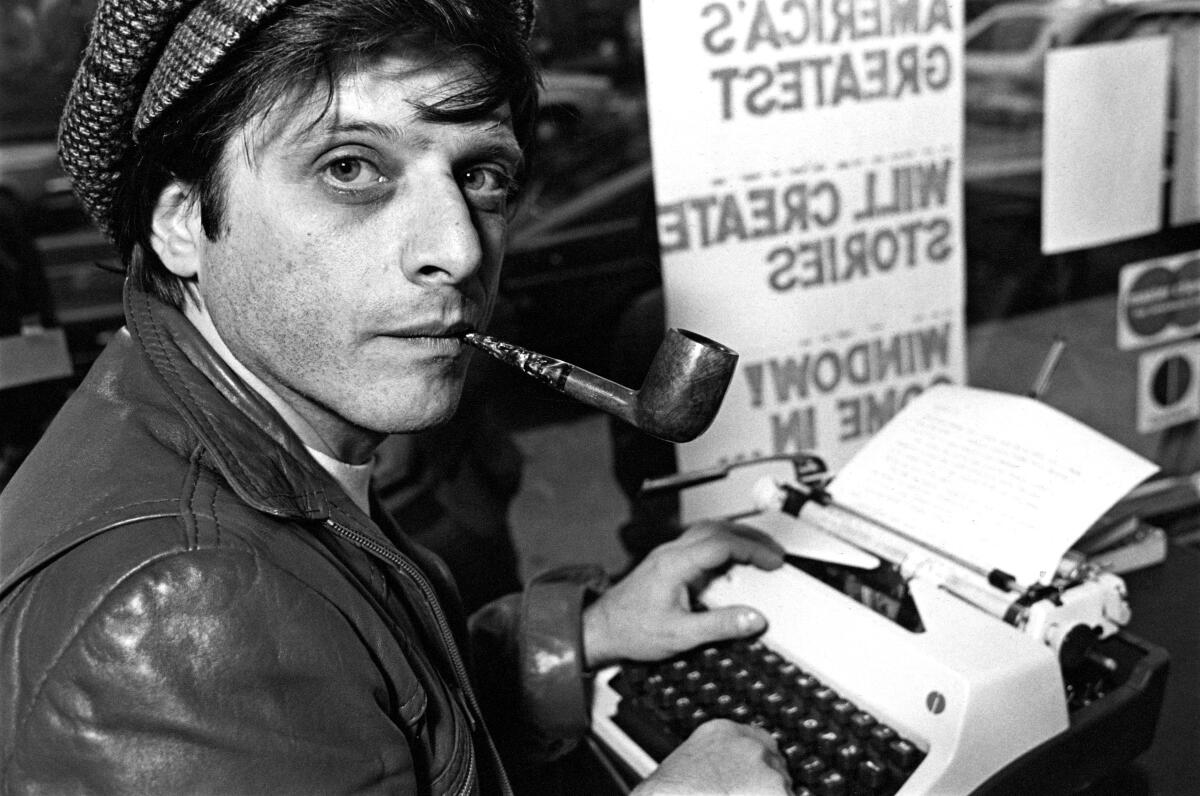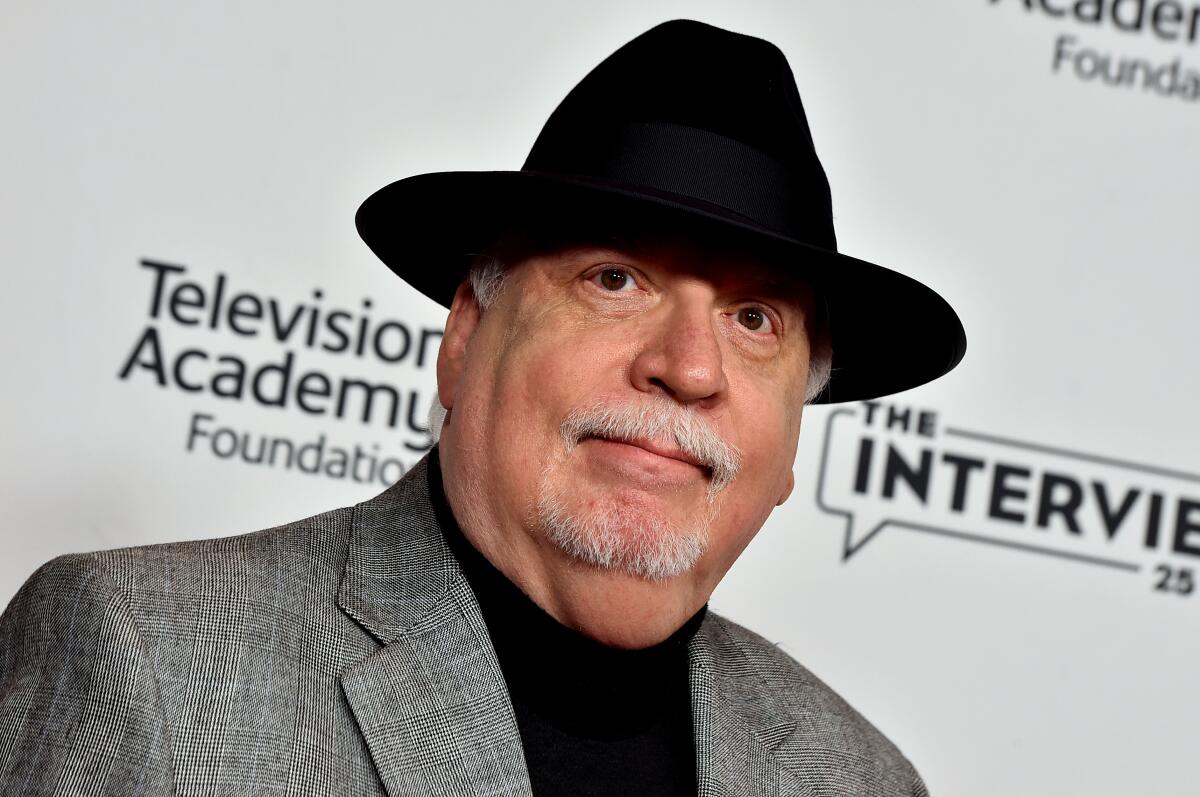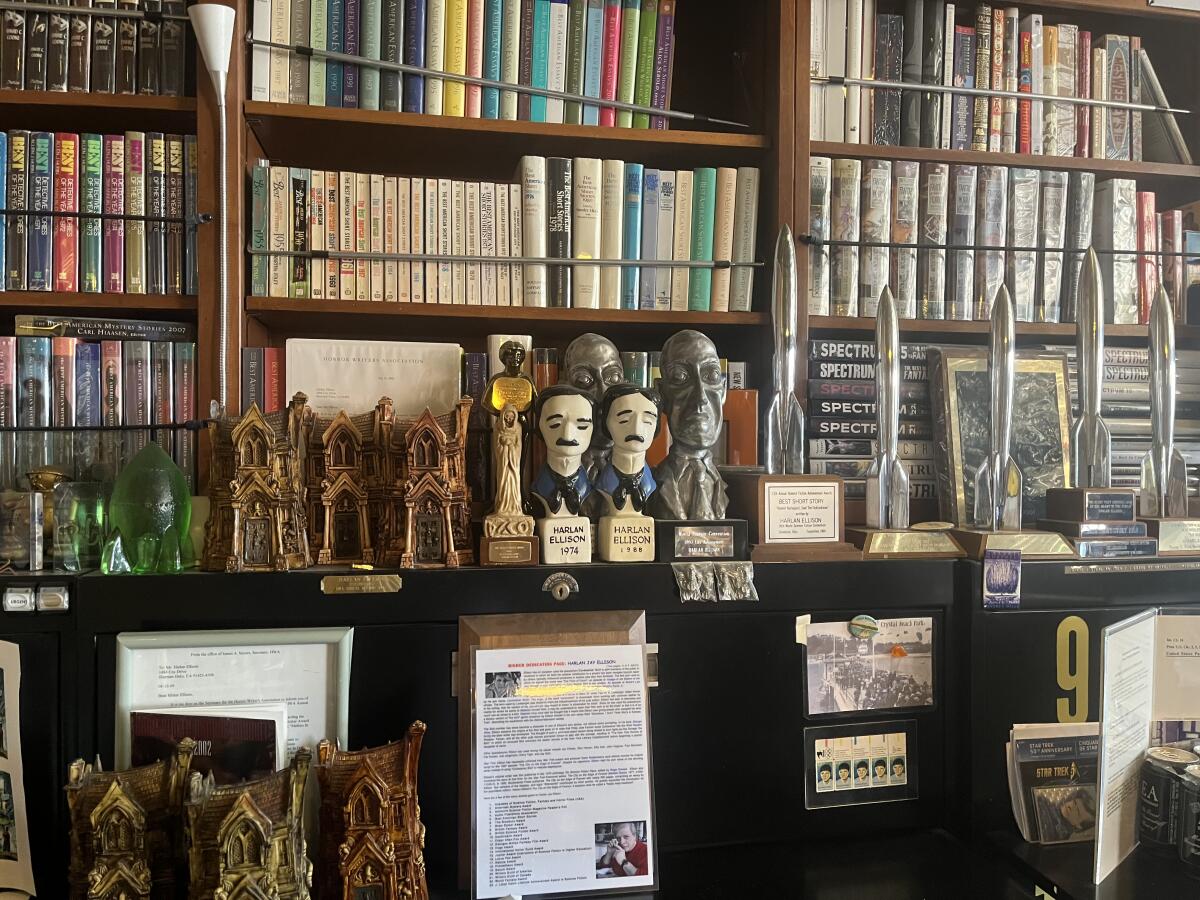Sci-fi pioneer Harlan Ellison’s L.A. Shangri-la offers a window into his complicated soul

- Share via
On a hilly street in Sherman Oaks, writer and producer J. Michael “Joe” Straczynski gestures to a row of gray gargoylesque heads mounted above an entryway. “If you look carefully, you’ll see they are the Watergate figures,” he says. “Nixon in the middle, surrounded by Mitchell, Dean, Haldeman, all of them.” He smiles, knowing that the mind that created this funky tableau belonged to none other than his closest friend, the eccentric author of speculative fiction Harlan Ellison.
Ellison’s career spanned six decades. His work garnered multiple Hugo, Nebula and Bram Stoker awards, among other honors. Willing to approach subjects that others deemed taboo or too complicated, he influenced a generation of writers, including George R. R. Martin, Stephen King and Neil Gaiman. This year will see the publication of four Ellison books, beginning with the all-new “Harlan Ellison’s Greatest Hits” in March, which has now gone through four print runs, to the anthologies “Dangerous Visions” (March), “Again, Dangerous Visions” (released today) and the long-awaited “The Last Dangerous Visions” in October.
For the record:
9:27 a.m. June 4, 2024A previous version of this story incorrectly described “Harlan Ellison’s Greatest Hits” as a newly revised book — it’s a new release — and misattributed some of Ellison’s remarks to Straczynski.
Harlan Ellison, who emerged as a major figure in the New Wave of science fiction writers in the 1960s and became a legend in science fiction and fantasy circles for his award-winning stories and notoriously outspoken and combative persona, died Wednesday night in Los Angeles.
Straczynski’s introduction to the new edition of “Dangerous Visions” includes something of a call to action: “‘Dangerous Visions’ ... was needed. And it may be just as needed now, at this moment, which has seen the return of a new generation of censors, banners and burners. Because the war for free expression is never truly won, only postponed until those on the other side of the barricades try again through different organizations, under different names, but always with the same tactics: fear and fire.”
Ellison died in 2018 at age 84. As literary executor of Ellison’s estate, Straczynski hopes that he can help keep alive not just Ellison’s artistic legacy, but also his politically progressive ideals (the author’s words were even used by the Writers Guild of America in support of its 2023 strike). Straczynski understands, from his long relationship with Ellison and countless visits to his house, that its structure, appearance, decor and contents tell stories about both his legacy and those ideals.

The Watergate grotesques form a small portion of the weird and sometimes wacky, but always carefully curated, world of Ellison. The largest portion of the facade features stone-intaglio pictographs that at first glance might be Egyptian hieroglyphs or Aztec sun symbols; closer examination reveals all sorts of imaginative creatures, from tiny robots to taloned divinities to monsters. Every piece of the house was carefully chosen by Ellison, and many pieces, including carved doors, staircases and even hinges and handles, were designed to his specifications. Next to the doorbell hangs a small framed sign: “Dig. Or split.” The author had no interest in catering to people who did not share his enthusiasms or worldviews.

Born in 1934, Ellison was a self-described “street rat” from a small Ohio town who moved to New York City after a brief stint in college, served in the Army and wrote his first novel before his 1962 arrival in California. He wrote for numerous TV shows — his “Star Trek” episode “The City on the Edge of Forever” is considered the original series’ best — and was even featured in Gay Talese’s famous Esquire piece “Frank Sinatra Has a Cold” in 1966. He wrote fiction and nonfiction himself, and in 1967 edited “Dangerous Visions,” which Isaac Asimov deemed a “second revolution” in science fiction.
“Harlan told me that when he was young, people called it ‘skiffy,’” Straczynski says. Ellison adopted the term and used it his entire life.
“No one took it seriously. Science fiction mainly involved white men arriving on other planets and attempting to colonize them, or survive insurmountable odds,” Straczynski said Ellison told him. “Before ‘Dangerous Visions,’ it’s fair to say sci-fi was technical, but Harlan dragged previously taboo subjects into the arena of science fiction.”

As Straczynski moves through the rooms of the house called “Ellison Wonderland,” his deep affection and respect for his friend remains evident. He points out the care with which more than 250,000 books are shelved, each hardback jacket fitted with transparent archival covers, the dust-free groupings of comic-book figurines, the room full of shelves specifically made to hold jelly glasses from the 1960s. He touches only the things he must, in order to make something visible, such as when in Ellison’s office proper he opens a tiny door in one of the Bram Stoker Awards given by the Horror Writers Assn. and takes out the mini plaque inside that holds the winner’s name and book title.

Everything, he says, is just as Ellison and his wife, Susan, arranged it. “Harlan believed that books were a form of art, and that his house was also a piece of art,” says Straczynski. “He was a neat freak. Sometimes I’d arrive to find him cleaning the grout on a tile floor with a toothbrush! He loved and honored art, whether that was framed art hanging on the walls or the books, and, of course, those were all about honoring other writers.”
Each room or wall or nook is covered with artwork, movie posters, books, ceramics and toys, but there are some surprises too. A gorgeous burl wood half moon bar, commissioned for but never delivered to the Titanic, conceals the entrance to a room containing Ellison’s archives, organized on accordion library shelves. A short distance away is a shelf of vintage mystery paperbacks that, when pressed in the correct spots, opens onto a kind of grotto. “Harlan lived by his principles, and so in the early 1970s, he had this constructed as a stop on the route some Vietnam draft resisters could take to Canada,” says Straczynski. Young men did stay in the room, which still holds blankets, canned goods and, of course, more books.
Nearly everyone who has been in science fiction over the last 60 years has a Harlan Ellison story, and I have two.
Ellison and Straczynski met in the late 1970s, when the latter decided to call the telephone number in one of Ellison’s books. “I couldn’t believe it when he picked up and barked, ‘Yes?’ into my ear,” Straczynski recalls. “Later I asked him why he would print his real phone number in a book. He looked down, kind of sheepishly, and said, ‘Chicks.’” Straczynski mimes Ellison making an embarrassed shrug.
At first, the two men communicated sporadically, with Ellison giving his trademark brutal feedback: “Here’s the deal. If it was any good, it would sell. If it’s not selling, it’s s—. My advice to you is stop writing s—.” As time passed and Straczynski became a regular guest at the Sherman Oaks dinner table, the assessment could still be harsh (“No one wants to sit with someone who doesn’t have anything to say, Joe”), but their connection grew stronger. Straczynski’s career took off as he moved from journalism to radio to horror fiction to cartoons to network shows to TV and big-screen films.
Straczynski pauses. “Harlan and I came from the streets and when you come from the streets you gotta look out for your buddy. For me, that was Harlan, and for Harlan, that was me.” Not only are the new editions Straczynski’s idea; he is petitioning the city of Los Angeles to give “Ellison Wonderland” landmark status so that it might be opened as a museum.
“When you walk into this house,” he says, “you are walking into Harlan’s brain. He loved the film ‘Lost Horizon’ and the concept of Shangri-la, a place where everything that gave you joy would exist. This house is Harlan’s Shangri-la, a place where a man who made his own rules lived.”
Patrick is a freelance critic, podcaster and author of the memoir “Life B.”
More to Read
Sign up for our Book Club newsletter
Get the latest news, events and more from the Los Angeles Times Book Club, and help us get L.A. reading and talking.
You may occasionally receive promotional content from the Los Angeles Times.










